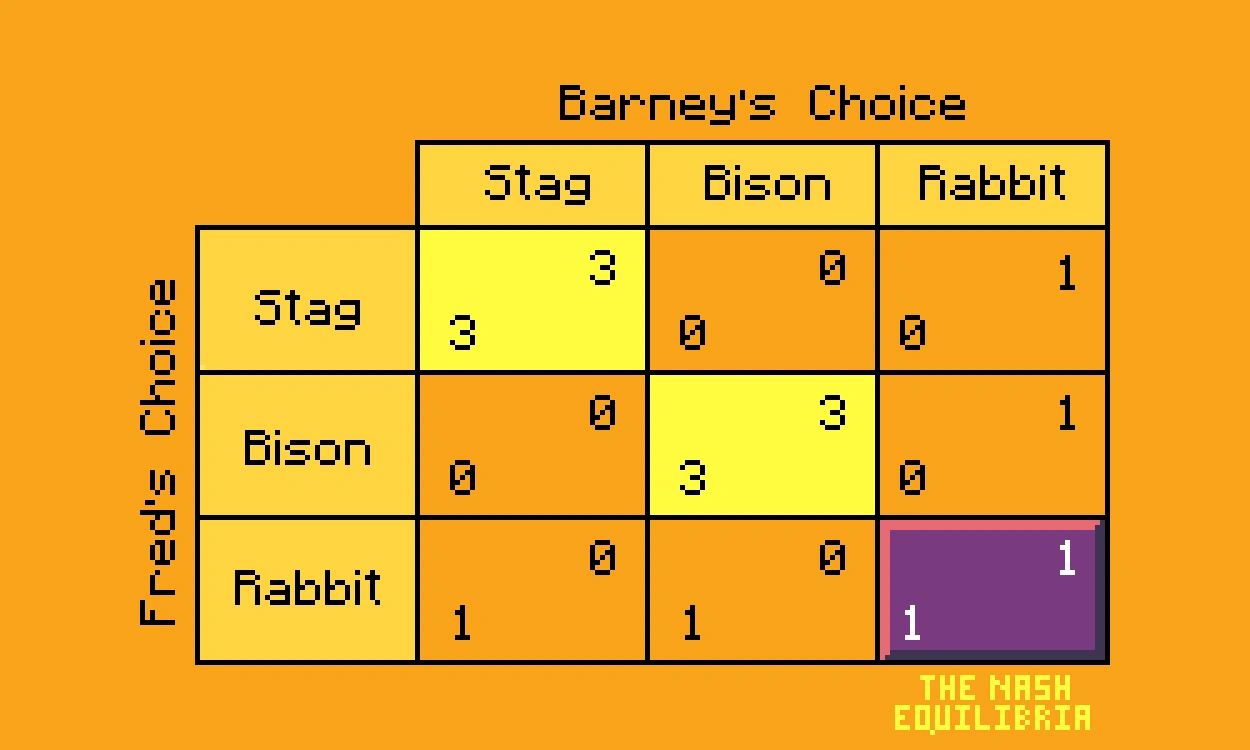Termed “The Hunt’s Conundrum” in a previous article, there are two pure-strategy equilibria found in the Stag Hunt’s traditional modeling for game theory. How do we pick one Equilibria over the other as the solution? Is there a way to predict cooperation towards hunting the big game, or to anticipate the independent route of the rabbit hunters?
“The Nash Equilibrium does not by itself give the answers. Some additional and different considerations are needed in order to determine ‘prominence’”, state Dixit & Nalebuff. Conceptually, “prominence” makes sense: One strategy, say “Stag”, may be prominent in Fred’s mind, but that is not enough for him to make that choice. He must ask himself whether the same strategy is also prominent for Barney. And that in turn involves asking whether Barney will think it prominent to Fred. But, how do we determine which Nash Equilibrium has “prominence”?
Dixit & Nalebuff continue on “prominence” with: “Selecting among multiple Nash equilibria requires resolution of a similar problem of thinking about thinking as does the concept of Nash equilibrium itself. To square the circle, the prominence must be a multilevel back-and-forth concept. For the equilibrium to be selected successfully when the two are thinking and acting in isolation, it must be obvious to Fred that it is obvious to Barney that it is obvious to Fred…that is the right choice. If an equilibrium is obvious ad infinitum in this way, that is, if the players’ expectations converge upon it, we call it a focal point.”
“The Stag Hunt” With Nash Equilibria & “Schelling Points”
Schelling’s Focal Points, later called, “Schelling Points”, introduced us to a coordination game in which the players searched for shared clues, making contact with each other through “some imaginative process of introspection,” as Schelling put it. “There must be something about the point they pick that distinguishes it – if not in their conscious reasoning, at least in our conscious analysis – from the continuum of all possible alternatives. The main interest of the players is to avoid confusion… [players] need to find some clue, or rule, or instruction to coordinate their choices. Whether a game has a focal point can depend on many circumstances, including most notably the players’ common experiences, which may be historical, cultural, linguistic, or purely accidental…” – The Strategy of Conflict.
A Schelling Point can be seen as a solution, or a course of action, that people converge on without talking to one another. The greater the number of people who observe a Schelling Point and interact with it, or take some action because of it, the more important the Schelling Point becomes. If a Schelling Point indicates a solution to a problem that can’t be obtained by any other means, that solution may exert a pull on those who discover it.
Now, let’s evaluate a “The Stag Hunt” game variant in which we find three Nash Equilibria. Where are the Equilibria in the example below?

At two of the Nash Equilibria, players chose to cooperate – (Stag,Stag) and (Bison,Bison). The last Nash Equilibria, found at (Rabbit,Rabbit), was one in which players chose to defect and go their own, independent routes.

Problematically, (Stag,Stag) and (Bison,Bison) have equal payoffs. Which Equilibrium will emerge as the outcome? I recall from above that “The Nash Equilibrium does not by itself give the answers” and that “Some additional and different considerations are needed in order to determine the prominence of a particular Equilibria”.
Let’s take a look at examples where, of the three Nash Equilibria, we should find a hunter’s strategy pointed to through some sort of additional consideration. We should find the hunters pulled to one particular equilibrium solution, a point that is distinguished from the others. Of the three equilibria, one should be seen as a Schelling Point, a way in which the hunters may coordinate their efforts.
Schelling Point Equilibrium Solution Coordination Example #1
Example 1 – What if the culture of the hunters was one in which the hunters were trained on how to field dress and prepare a rabbit, but not any of the big game options?
In this case the meat obtained from the successful hunting of either the stag or the bison would result in wasted utility – the bison and stag yield a “3” in possible utility, but that doesn’t mean the hunters can successfully capture that utility. In this case, the hunters are unskilled in preparing and field dressing big game, and as a result the meat would go bad before they could get it back to their village. This being the case, which of the three Nash Equilibria do you think the hunters would choose?

Above, the clear and prominent Nash Equilibrium is found at (Rabbit,Rabbit) with a payoff of “1” for each of the hunters. In case you missed it, the Schelling Point exists at the (Rabbit,Rabbit) Nash Equilibrium.
Schelling Point Equilibrium Solution Coordination Example #2
Example 2 – What if the culture of the hunters was one in which there was a love for the taste of stag meat, especially, and a disdain for the rate-like nature of rabbits, specifically?
In this case it is safe to assume that the hunters will not choose the independent strategy equilibria (Rabbit, Rabbit). Even though rabbits are plentiful, cultural disdain over the mammal will push the hunters away from this strategy. There is an equal payoff found at (Bison,Bison) and (Stag,Stag), however. In consideration of the hunters’ love for the taste of stag meat, which of the two big-game Nash Equilibria do you think the hunters would choose?

“Stag all day, ery day,” say Fred and Barney! The Schelling Points of Thomas Schelling make the solution obvious… remembering that “Uniqueness conveys prominence, uniqueness avoids ambiguousness,” the unique and prominent choice is the Nash Equilibrium found at (Stag,Stag) with a payoff of “3” for each of the hunters. In case you missed it again, the Schelling Point in this case exists at the (Stag,Stag) Nash Equilibrium.
Thanks for reading!
